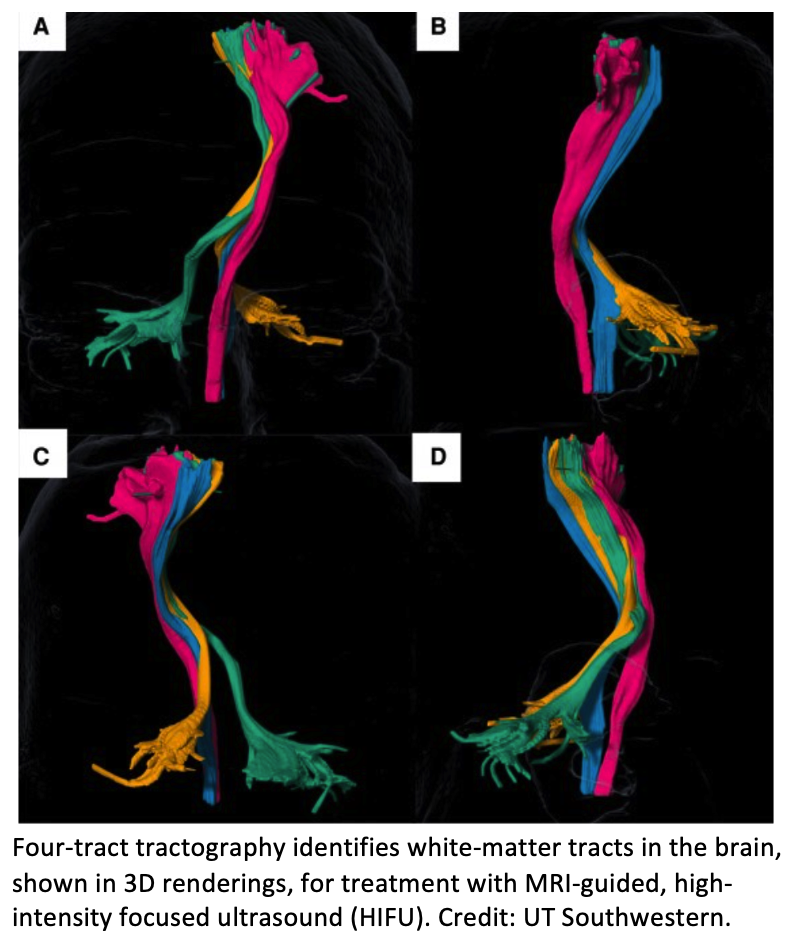UTSW Develops Technique to Improve Targeting of MR-Guided Focused Ultrasound in the Brain
 UT Southwestern physicians have developed an improved targeting method, four-tract tractography, to personalize MRI-guided, high-intensity focused ultrasound (HIFU) to treat medication refractory tremor in essential tremor and tremor-dominant Parkinson’s disease. Published in Brain, the clinical cases utilizing this approach suggest it enables more precise targeting of the brain, decreases treatment times, reduces side effects and improves treatment response.
UT Southwestern physicians have developed an improved targeting method, four-tract tractography, to personalize MRI-guided, high-intensity focused ultrasound (HIFU) to treat medication refractory tremor in essential tremor and tremor-dominant Parkinson’s disease. Published in Brain, the clinical cases utilizing this approach suggest it enables more precise targeting of the brain, decreases treatment times, reduces side effects and improves treatment response.
“Historically, the target for tremor could not be seen on standard high-resolution magnetic resonance images, so landmark-based methods have been used,” said Bhavya R Shah, MD, Assistant Professor of Radiology and Neurological Surgery, Investigator in the Peter O’Donnell Jr Brain Institute and corresponding author. “By using tractography and other advanced magnetic resonance methods, we are working to identify the precise location of the target in individual patients and improve patient outcomes.”
MRI-guided HIFU ablation of the ventral intermediate nucleus of the thalamus has been approved by the US FDA for treatment of essential tremor and tremor-dominant Parkinson’s. The efficacy and safety of the procedure are dependent on precise targeting; however, MRI cannot directly delineate the target. Thus, indirect methods using landmarks are utilized to identify the correct region.
Use of indirect targeting for HIFU ablation can result in significant adverse side effects, including weakness, numbness, and paresthesia in nearly a third of patients one month post-treatment, that might be mitigated by using techniques to more directly target the region of the brain and identify regions to avoid.
To this end, the UT Southwestern physicians developed an improved, standardized four-tract tractography for HIFU using an FDA-approved surgical planning software that will allow for easy implementation into clinics.
The four-tract tractography method builds off previous work by Dr Shah in 2020 that demonstrated the feasibility of advanced MRI techniques to identify tremor-associated white-matter tracts.
In the latest study, data were analyzed from 18 patients who underwent MRI-guided HIFU and had at least three months of follow-up post-treatment.
Use of the four-tract tractography for ablation suggests that this method yields decreased adverse effects. None of the patients experienced weakness, numbness, or paresthesia post-treatment; three patients experienced transient (three weeks) imbalance, common after magnetic resonance-guided HIFU.
Though this retrospective review was limited by a small sample size of patients treated in one center with a short follow-up, the results suggest promise for four-tract tractography to produce better outcomes for patients who need this procedure. A multicenter trial is planned with other US sites, including the University of California San Francisco, the Mayo Clinic in Rochester, Minnesota, the University of Colorado, and an international site in Spain.
Several other sites have arranged to come to UTSW to work with Dr Shah to learn his approach. This work represents a step forward in using advanced imaging to create personalized solutions for these patients, said Dr Shah.